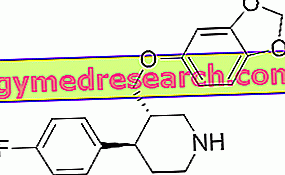Generality
Glioma is a tumor that originates in some particular cells of the central nervous system, the so-called glia cells . Like any tumor, glioma is also caused by a genetic mutation, but the exact cause of this mutation is still under investigation.
There are different types of gliomas: their characteristics depend mainly on the type of cell of the affected glia and the growth rate of the tumor mass. The most severe gliomas, such as glioblastoma multiforme, are characterized by a high rate of growth.

Knowing a glioma in detail (therefore, location, size and gravity) allows you to set the most appropriate therapy.
Severe gliomas have an always negative prognosis.
A brief reminder of what a brain tumor is
A brain tumor is a mass of cells that is formed and grows inside the brain in a completely anomalous way, due to a genetic mutation .
Depending on the characteristics with which it occurs, a tumor can be defined in various ways:
- Benign or malignant . Brain tumors characterized by slow growth of the abnormal cell mass are considered benign; Brain neoplasms with fast growth are instead considered malignant.
- Primary or secondary . Primary brain tumors are those that originate directly in the brain or in parts adjacent to it (for example, the meninges or the pituitary gland). Secondary brain tumors, on the other hand, are the result of a process of metastasization, in which the cells of a neoplasm arisen elsewhere (for example, in the lung) have moved and invaded the brain.
Furthermore, there is a third, more general, classification criterion that distinguishes brain tumors depending on the degree of severity . For more information on this, read the chapter on what a glioma is.
What is a glioma?
A glioma is defined as a tumor that develops from the glia cells (or glial cells ) of the central nervous system; it can therefore affect both the brain and the spinal cord, however, given the rarity with which it occurs in the spinal cord, glioma tends to be considered an exclusive neoplasm of the brain.

Figure: a glioma, indicated by the red arrow. It is a glioblastoma multiforme. From the site: //en.wikipedia.org/
WHAT IS THE GLIA?
Within the nervous system, the glia provides support and stability to the intricate network of neurons present within the human body (a network that has the task of transmitting nerve signals). Furthermore, the cells of the glia communicate with the same neurons through growth factors and trophic factors (ie nourishment), to keep them healthy and direct their development.
The glia implant is present, with different actors, both in the peripheral nervous system ( SNP ) and in the central nervous system ( CNS ): in the SNP, the cells that compose it, are the so-called Schwann cells and satellite cells ; in the CNS, on the other hand, its cellular elements are oligodendrocytes, microglia cells, astrocytes and ependymal cells .
Schwann cells (SNP) and oligodendrocytes are distinguished from the others for two reasons: in addition to wrapping themselves around the prolongations of neurons (axons), they produce a whitish substance called myelin . Myelin serves to increase the speed of nerve signal conduction.
CNS glia cells
| Cells of the SNP glial cell
|
 Figure: a neuron, its main components (body, dendrites, axon and axonal terminals), and two cells of the CNS glia (an astrocyte and an oligodendrocyte). It can be seen that both glial cells connect to the neuron, but only the oligodendrocyte wraps itself around the axon. From the site: www.monicamarelli.com | |
DIFFERENT KIOMS TYPES
Based on the affected glial cells, there are different categories of gliomas:
- Astrocytomas, because they arise at the level of astrocytes
- Oligodendrogliomas, because the home of origin are the oligodendrocytes
- Ependymomas, because they affect ependymal cells
- Mixed gliomas, because they affect, simultaneously, both oligodendrocytes and astrocytomas
GRAVITY OF A GLIOMA: THE FOUR DEGREES
As mentioned in the introductory part, brain tumors can also be distinguished according to the degree of severity . The grades are four, from I to IV, and - in addition to taking into account the growth rate - they also take into account infiltration and diffusion capacities .
Tumors with slow growth and localization at one point are considered grade I and II tumors; all infiltrating and rapidly growing tumors are instead considered to be of III and IV degree. Over time, it is possible that a grade I or II tumor mass will evolve and become grade III or IV.
This classification is very useful especially in the case of gliomas, as they can present themselves with rather different connotations (different growth, different location, etc.).
Some examples of gliomas, divided by degree of severity
- Grade I : pilocytic astrocytoma, subependimoma
- Grade II : diffuse astrocytoma, oligodendroglioma, pleomorphic xanthoastrocytoma
- Grade III : anaplastic astrocytoma, anaplastic ependymoma, anaplastic oligodendroglioma, anaplastic oligoastrocytoma
- Grade IV : glioblastoma multiforme (is an astrocytoma)
NB: pleomorphic xanthoastrocytoma is a middle ground between grade I and grade II.
Epidemiology
Gliomas represent about 80% of primary brain tumors and about 30% of malignant ones.
Glioblastoma multiforme, which is one of the most common and deadly neoplasms of the brain, affects people aged 55 and above.
Grade I and II astrocytomas usually occur in subjects aged 20-30, while anaplastic astrocytomas and oligodendrogliomas predominantly affect individuals in their forties.
Causes
The precise causes, which cause gliomas, have not yet been fully clarified.
However, since it is a form of brain tumor, researchers believe that there is a genetic mutation at the origin of the glia cells.
From what this mutation is triggered is still the subject of study: the only known risk factors are some rare genetic diseases, which due to their rarity cannot explain most of the gliomas and brain tumors.
THE KNOWN RISK FACTORS
After numerous scientific studies, the researchers discovered that there are rare genetic conditions strongly linked to the onset of brain tumors (in general) and gliomas (in particular).
These predisposing circumstances are:
- Neurofibromatosis type 1 and 2
- Tuberous sclerosis
What is neurofibromatosis?
Neurofibromatosis is a rare genetic disorder that affects the nervous system and alters certain functions. To trigger the disorder is the mutation of a gene with a fundamental role in regulating nerve growth.
Neurofibromatosis can be transmitted from parents to a child, but can also arise spontaneously at an embryonic level, due to a genetic error.
There are two types of neurofibromatosis, type 1 and type 2, each having its own specific characteristics.
Symptoms and Complications
The symptoms of a glioma are very varied and depend on the size, location and infiltration ( degree ) of the tumor mass.
To understand what has just been said, it may be useful to make the following example, which takes into account the position of the neoplasm. A tumor at the level of the parietal lobe of the brain (ie in the lateral part) can cause difficulties in speaking, understanding what is said, writing, reading and coordinating certain movements; a tumor at the level of the occipital lobe (ie in the posterior part) can instead cause a decrease in sight.
GENERAL SYMPTOMS
Bearing in mind what has just been stated, the symptoms that could arise are:
- Headache . It represents the most characteristic symptom that distinguishes all brain tumors. It is caused by the thrust of the tumor mass against the skull and adjacent areas (intracranial pressure); for this reason, it tends to increase in intensity gradually, parallel to the growth of the tumor.
- Sense of nausea and vomiting
- Attacks of epilepsy
- Visual disturbances
- Difficulty speaking
- Sudden changes in behavioral personalities
- Intracranial hemorrhage : especially in cases of glioblastoma multiforme.
Diagnosis
When symptoms suggest a brain tumor, the path of diagnosis begins with an accurate neurological examination . However, this does not allow us to understand whether it is a glioma or another brain neoplasm: to clarify this doubt, we need instrumental tests and the collection of a small sample of tumor tissue ( brain biopsy ).
NEUROLOGICAL EXAMINATION
During the neurological examination, the doctor submits the patient to various checks, aimed at assessing sight, hearing, balance, coordination and reflexes. The partial or total loss of one of these abilities provides reliable information on the area of the encephalon involved.
INSTRUMENTAL TESTS
Instrumental tests such as computerized axial tomography ( CT ) and nuclear magnetic resonance ( NMR ) guarantee clear images of the brain and its internal anatomy.

Figure: Nuclear magnetic resonance of a glioblastoma multiforme. The so-called ring of enhacement, which surrounds the tumor, can be seen.
From the site: www.surgicalneurologyint.com
In fact, through RMN and TAC, information is obtained regarding the location, size and type of tumor.
For example, the glioblastoma multiforme occurs surrounded by a ring, the so-called enhancement ring.
CEREBRAL BIOPSY
The brain biopsy takes place after identifying the area affected by the glioma; the examination consists in taking a small portion of the tumor mass and in its observation under a microscope.
The characteristics of the tumor cells clarify the nature of the neoplasm: which cells have been affected, the degree and the malignancy.
Treatment
There are several therapeutic approaches for the treatment of gliomas. The choice of a specific course of therapies and the exclusion of another depends on the following factors:
- Location, size, grade and type of glioma
- Age and health of the patient
The most commonly used treatment is surgical removal of the tumor mass (removal). This operation is very delicate, as it involves performing a craniotomy and removing the tumor without damaging the surrounding healthy parts.
The other treatments adopted are: radiotherapy, chemotherapy and radiosurgery . These can be put into practice either after the surgical removal operation, as a completion of this, or as a stand-alone treatment (for example, if the tumor is in a position inaccessible to the surgeon).
For more information about the treatment modalities mentioned above, the reader is advised to consult the page on the site dedicated to brain cancer (chapter on therapy).
Below, on the other hand, it will be possible to find the treatment methods implemented in the presence of certain gliomas.
TREATMENT OF THE GLIOMES OF IE GRADE II
Patients with grade I and II gliomas are encouraged to have the removal surgery, as, usually, this operation is fairly successful: the tumor masses, in fact, are not particularly large and infiltrating, therefore they can be completely removed and without problems.
Should the surgeon opt for a partial resection of the tumor (for precautionary reasons or because the tumor is in a delicate position), at the end of the operation we proceed with radiotherapy or chemotherapy sessions.
When is the operation not recommended? The only situations that could lead to non-operation are old age or the patient's precarious state of health.
TREATMENT OF III DEGREES
The removal of the III degree gliomas must always be carried out (if it is in a reachable location) and as far as possible, that is, the most tumor mass that can be removed.
At the end of the procedure, the radiotherapy and / or chemotherapy cycles are fundamental to eliminate (hopefully permanently) what remains of the neoplasm.
Unfortunately, even when the surgery is performed in a precise and timely manner, the chances of recovery are very small.
THE TREATMENT OF GLIOBLASTOMA
Glioblastoma multiforme is, as has been said, the most common severe glioma. It has a fast growth rate and a remarkable infiltrating capacity.
The only feasible cure, in these unfortunate situations, consists in the removal of the most consistent part of the tumor, combined with radiotherapy and chemotherapy (exactly as in the case of III degree gliomas, with the only difference that, for glioblastomas, the success of the intervention is minor, as is the subsequent life expectancy).
If there is a recurrence, it is possible to intervene again and perform another tumor resection.
Prognosis
The prognosis, for an individual with glioma, depends on the type of glioma itself.
As we have seen, in fact, the forms of grade III and IV, in addition to having much more dramatic effects than the forms of grade I and II, are even more difficult to cure.
Another factor not to be overlooked, then, is the patient's age: young patients have a longer post-intervention life expectancy than elderly patients, even if they have been struck by a glioma of grade III or IV.
Below is a brief account of the life hopes of those who have been operated on by glioma.
- Grade I and II gliomas (for example, pilocytic astrocytoma): post-intervention life expectancy is high; usually, no fallout occurs.
- III degree gliomas (for example, anaplastic astrocytoma): the average survival is about 2-3 years.
- Grade IV gliomas (for example, glioblastoma multiforme): the survival rate after one year is 30%; after two years, it is 14%.



